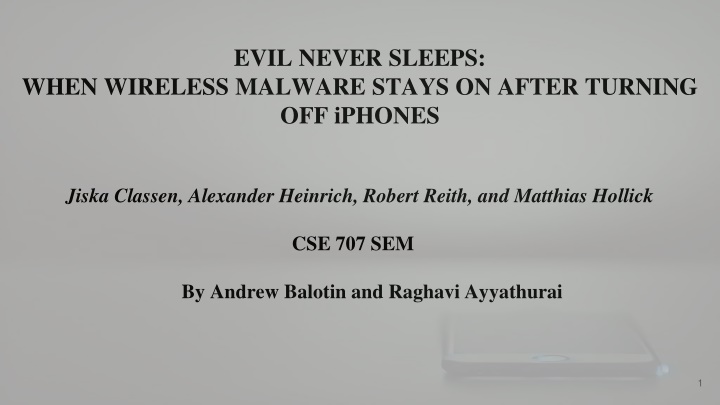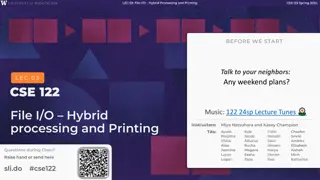
Identifying Security Flaws in iOS Low-Power Mode for iPhones
Explore the risks of wireless chips functioning in Low-Power Mode on iPhones, even after being turned off. Understand vulnerabilities in Find My LPM implementation and risks of modified Bluetooth firmware running malware. Stay informed about the potential threats to your device's security.
Download Presentation

Please find below an Image/Link to download the presentation.
The content on the website is provided AS IS for your information and personal use only. It may not be sold, licensed, or shared on other websites without obtaining consent from the author. If you encounter any issues during the download, it is possible that the publisher has removed the file from their server.
You are allowed to download the files provided on this website for personal or commercial use, subject to the condition that they are used lawfully. All files are the property of their respective owners.
The content on the website is provided AS IS for your information and personal use only. It may not be sold, licensed, or shared on other websites without obtaining consent from the author.
E N D
Presentation Transcript
EVIL NEVER SLEEPS: WHEN WIRELESS MALWARE STAYS ON AFTER TURNING OFF iPHONES Jiska Classen, Alexander Heinrich, Robert Reith, and Matthias Hollick CSE 707 SEM By Andrew Balotin and Raghavi Ayyathurai 1
KEY TERMS NFC (Near Field Communication) : Wireless technology that allows devices to exchange data over short distances. UWB (Ultra-Wideband): Provides precise location tracking for features like digital car keys or finding lost devices. Low-Power Mode (LPM) : A power-saving mode where Bluetooth, NFC, and UWB chips remain active. 3
KEY TERMS (Cont.) Express Mode: A feature that allows NFC-enabled services like payment cards to work without unlocking the iPhone, active even in Low-Power Mode. Find My: A feature that broadcasts iPhone s location even when powered off. Bluetooth Low Energy (BLE) : A power-efficient Bluetooth protocol used in the Find My network for locating offline devices 4
INTRODUCTION Wireless chips (Bluetooth, NFC, UWB) on iPhones continue operating in Low-Power Mode (LPM) even after the phone is switched off or when iOS shuts down due to low battery In battery-low shutdown, Bluetooth-based Find My allows users to locate their iPhones even when they are turned off Express Mode allows access to digital cards (student ID, transit, credit) and keys without unlocking the phone and is available in LPM These cards and keys can still be used for up to 5 hours after the phone enters battery-low shutdown 5
INTRODUCTION (Cont.) Initially, NFC alone supported Express Mode, but the new Digital Car Key (DCK) 3.0 protocol now uses Bluetooth and UWB. The bluetooth and UWB chips are hardwired to the Secure element (SE) in the NFC chip which stores secrets that are available in LPM. Since this is hardware based and not software, wireless chips can no longer be trusted to be turned off after shutdown. 6
Research Focus: Analyzing Vulnerabilities in iOS Low-Power Mode This paper explores the security analysis of new LPM features introduced in iOS 15: It identifies flaws in the Find My LPM implementation, limiting the total advertisement time to 24 hours, even after a reboot. It also identifies that the Bluetooth LPM firmware can be modified to run malware. 7
NFC LOW-POWER MODE Documented by Apple iOS implements secure wireless payments through an NFC chip with a Secure Element (SE). The SE stores sensitive data (e.g., credit cards, digital car keys) and runs a JavaCard platform to manage secure transactions. It ensures applets are isolated from each other and remain protected even when iOS or other apps are compromised. Data within the SE remains protected and is not accessible by iOS. The Secure Enclave Processor (SEP) and SE are paired in-factory, enabling encrypted and authenticated communication between them. However, Express Mode can bypass the SEP to allow quicker access to cards and keys. 8
BLUETOOTH AND UWB LPM iOS 15 introduced two new LPM features: 1. The Find My network (Bluetooth-based). 2. Digital Car Key (DCK) 3.0 (UWB-based for secure distance measurement). Both features are undocumented by Apple 10
How was the Bluetooth and UWB LPM reverse Engineered? 11
Logging On an active device logs can contain millions of messages within a couple of days Logs can be searched Naming of many features inside the log messages is often inconsistent LPM is called wither LPEM or LEPM DCK 3.0 is internally called Alisha Often the logs are hard to reach After combing through lots of logs there are hints that the UWB chip attempts to enter LPM on power off Service checks if UWB Express is active on battery low shutdown 12
Hardware Large online community that shares leaked smartphone schematics Using these schematics it shows the SE is hardwired to the UWB and Bluetooth Schematics also show trace connections between other chips to estimate threats by LPM Also contains all the protocols for PCIe and I2C 13
Binaries Analyzing different iOS versions allows for feature comparison across different software and hardware revisions Recent iOS version have a Dynamically Loaded Library shared cache which contains a lot of proprietary functionality Names in driver interfaces reveal hardware capabilities that are otherwise hard to reverse engineer 14
UWB Firmware Analyzed the UWB firmware Early versions of the iPhone 11 UWB firmware had lots of debug prints for communication with the SE Lots of testing and logging was removed in later versions Alisha, the nickname for the DCK 3.0 protocol started appearing in the iOS 14.3 firmware LPM support for UWB was added in the same release 15
Find My and Bluetooth LPM Functionality 16
Find My LPM An offline finding network using Bluetooth Low Energy (BLE). It helps locate iPhones and other Apple devices, even when not connected to the internet. Offline devices regularly send Bluetooth Low Energy (BLE) advertisements, devices with a network connection can scan for these advertisements and then report lost devices to their legitimate owners. Each device has a master beacon key that is synchronized with the user s iCloud keychain. BLE advertisements use rolling public/private key pairs that rotate every 15 minutes on iPhones to protect against device tracking and prevent linking keys to the device without proper access. 17
Digital Car Key (DCK) LPM DCK 3.0 uses both Bluetooth and Ultra-Wideband (UWB) technologies to enhance security and enable precise distance measurement for keyless entry. Bluetooth is responsible for setting up the initial connection between the iPhone and the car. The DCK system scans for BLE devices, runs a Generic Attribute (GATT) service for data exchange over BLE, and retrieves key material from the SE using I2C protocol. In contrast to the Bluetooth chip, the UWB chip remains in sleep mode most of the time to conserve power. 18
Digital Car Key LPM (Cont.) : Bluetooth sends a wake signal to the UWB chip when precise distance measurement is required. This power-efficient setup ensures that UWB is only active within a limited time window. Ultra-Wideband (UWB) provides secure distance measurement, determining the exact range between the iPhone and the car. UWB allows for precise localization, ensuring the car unlocks only when the iPhone is within a specific, close range, adding an additional layer of security. 20
Applications - Adversary Model In the application layer, the adversary is assumed to have physical access to the iPhone and seeks to exploit vulnerabilities in Low- Power Mode (LPM) without manipulating the phone s firmware or software. The adversary's goal might be to disable Find My for theft or to exploit Express Cards and Keys to make unauthorized payments. 23
Security Flaws in Find My LPM: The Find My feature is limited by LPM, where Bluetooth advertisements (used for locating lost devices) may stop broadcasting sooner than intended or fail to broadcast under certain conditions. Users are not notified about these Find My limitations, leading to a false sense of security that their iPhone will remain locatable for longer periods. The reduced broadcasting of Find My advertisements during LPM makes it easier for attackers to avoid detection and disable tracking. When an iPhone is rebooted, it retrieves a Find My token from NVRAM storage, which persists through shutdowns and reboots, ensuring the continued use of Find My. 24
If the iPhone has an internet connection before the first unlock after reboot, it connects to Apple's servers to report the location. However, Wi-Fi keys are only available after the first unlock, and cellular connections may fail if there is a SIM PIN or the SIM card was removed. Express Mode allows selected cards and keys (e.g., payment cards, car keys) to be used without authentication for up to 5 hours after the phone shuts down due to low battery. This mode introduces a security risk if a stolen iPhone can still be used for payments or physical access (e.g., unlocking a car). 25
Firmware - Adversary Model This section assumes an attacker with privileged firmware access, meaning they can send custom commands to the firmware, modify firmware images, or even gain code execution over-the-air. This type of attack requires significant control, which is difficult but possible if there are vulnerabilities in the system. 26
Firmware Tampering: Local Firmware Modification: Attackers with system-level access can modify the firmware of components that support Low-Power Mode (LPM). This could allow attackers to maintain control of the iPhone even when the phone is powered off. This type of control is valuable for persistent exploits targeting high-value individuals like journalists. The iOS 15 LPM-supporting chips include NFC, UWB, and Bluetooth. Of these chips, the NFC chip is the most secure, as its firmware is both encrypted and signed. However, attempts to bypass its secure bootloader have been unsuccessful. The Bluetooth firmware is the least secure, as it is neither signed nor encrypted, and lacks secure boot. This leaves the Bluetooth chip vulnerable to malware even when the phone is off. 27
Remote Code Execution: Attackers who do not have system-level access can still attempt to remotely execute code on the LPM-enabled chips. In the past, various vulnerabilities have been disclosed in Bluetooth chips used in iPhones. Reconfiguring Firmware Options: Even if firmware is protected, an attacker with system-level access could still send custom commands to manipulate the chips. For example, they could alter the Bluetooth firmware to manipulate how Find My LPM works, such as modifying the advertisement intervals or inserting their public keys to track the device. 28
Implications: If firmware is compromised, it exposes the Secure Element (SE) used for storing sensitive information (like car keys and payment data) to potential attacks. The compromised Bluetooth firmware could allow attackers to access the SE and compromise the security of stored information, weakening trust in the SE s protection. 29
Hardware - Adversary Model The model assumes that neither the attackers nor the legitimate users manipulate the hardware. The analysis focuses on which components could be stealthily powered on while the iPhone is off and the applications attackers might build using Low-Power Mode (LPM). 30
Suitable chips: Many chips in an iPhone are controlled by the Power Management Unit (PMU), which could enable them to stay active in LPM. However, the goal of LPM is to not significantly drain the battery, so only certain battery- friendly chips are suitable for LPM operation. These chips must have a way to interact with the outside world or the user, such as wireless chips or buttons. Most chips are also connected to the Application Processor (AP) or the Always-on Processor (AoP). The AoP runs Apple s RTKitOS, which is always active and waits for hardware events and triggers. The AP, which runs iOS, can go to sleep to save power. Neither the AoP nor the AP should be running in LPM, as they consume too much power. All wireless chips (e.g., Bluetooth, UWB) are connected to the PMU and could operate in LPM independently of iOS or the Application Processor. 31
Detection and Deactivation: Detecting whether chips were running LPM firmware or disabling LPM entirely is not possible with current iOS on-board tools. Additional monitoring hardware is needed to detect wireless transmissions in LPM. Logging: UWB chips have storage for crash logs, which are read out after system boot, while Bluetooth LPM firmware also supports logging. However, these logs are intended for iOS developers and cannot be accessed without jailbreaking the device. Users cannot determine if LPM firmware was running or what actions it performed on a device without compromising the system. 32
Disabling LPM: LPM support is implemented in hardware and cannot be removed through system updates. A potential solution for privacy-conscious users would be a hardware switch to disconnect the battery, similar to how Apple disconnects the microphone on MacBooks when the lid is closed. Other Protection Methods: Users concerned about being spied on through LPM could install a transmission monitoring device to detect wireless communications, or use a Faraday bag to block transmissions, though small holes or gaps can lead to leakage. 33
Bluetooth Firmware Modification Researchers use specialized tools to extract, analyze, and alter firmware, exposing weaknesses in firmware protection mechanisms. They delve into the process of dumping and modifying the firmware of iPhone's wireless chips, particularly the Bluetooth chip, to uncover potential vulnerabilities. The analysis highlights the security risks of firmware tampering, especially in Low- Power Mode (LPM). 34
Dumping and Loading Firmware Firmware Dumps: Broadcom Bluetooth chips store most of their firmware in Read-Only Memory (ROM). To fully understand the firmware, researchers need to perform a complete dump, which includes the ROM. The ROM is readable with a vendor-specific Host Controller Interface (HCI) command, supported by all Broadcom chips, including the ones in iPhone 13. Apple's Core Bluetooth framework does not allow sending these HCI commands, but researchers bypass this on jailbroken iPhones using tools like InternalBlue. 35
Jailbreaking and InternalBlue: The InternalBlue tool attaches itself to the Bluetooth subsystem to send HCI commands and interpret received events. The initial version of InternalBlue only supported legacy chips connected via UART (Universal Asynchronous Receiver-Transmitter), but recent modifications allow support for newer chips with PCIe drivers. Firmware Patching with Patchram: Patchram is a method for temporarily patching the firmware in RAM. Any 4-byte value in ROM can be mapped to another 4-byte value in RAM, allowing function calls in ROM to be replaced by calls to functions in RAM. This process works because RAM is writable and executable. Modern Broadcom chips have 256 Patchram slots, allowing multiple patches to be applied. 36
Legacy vs Modern Chips: Legacy Bluetooth chips use UART for communication, which limits the patch size to a maximum of 255 bytes. The newer chips, starting from the iPhone Xs and later, use PCIe for communication, allowing for the transfer of larger patch files in one go. Patch Format: The patch format used by newer chips involves transferring a large .bin patch file at once. This was reverse-engineered to allow custom patches to be installed on modern iPhones. 37
Firmware Patch Image Upload: Most Bluetooth communication on iOS is handled by the Bluetooth daemon. However, for low-level tasks, a tool called BlueTool is used to send HCI commands and load firmware patches. BlueTool can be accessed via Cross-Process Communication (XPC) calls from other daemons or used interactively through a command line interface. 38
Analyzing and Modifying Firmware Patch Analysis Tooling: The researchers developed several tools to analyze and modify the Bluetooth firmware. These include: A Python script that can extract patch regions from firmware and reassemble patch files with correct Cyclic Redundancy Checks (CRCs). An IDA Pro script that parses the patch configuration data. Another IDA Pro script that identifies functions calling the abort handler. These tools are flexible and have been used for multiple purposes, including increasing BLE reliability, enabling chips to send and receive ZigBee, and testing against security issues in the Bluetooth specification. 39
Firmware Modification: Using the tools, researchers can load any patch file on top of an existing InternalBlue ROM dump for static reverse engineering. The researchers modified existing patch files and loaded them onto running iOS devices to test whether the firmware can be modified and still function correctly. This dynamic analysis helps identify potential issues or vulnerabilities within the Low-Power Mode (LPM) module. 40
Firmware Tampering Example: An example of malware in firmware demonstrates how attackers could modify the Bluetooth firmware to observe or tamper with communication between the Secure Element (SE) and Bluetooth chip when using Digital Car Key (DCK) 3.0. This is a significant security risk as it would allow attackers to access or manipulate sensitive data such as keys for digital car access. Preventing Firmware Tampering: Although firmware protection mechanisms exist, the Bluetooth chip on iPhones does not fully prevent tampering. The researchers were able to modify the firmware during runtime. The patch they altered demonstrates that even though iOS has certain protections, they are not sufficient to stop advanced firmware modification attacks. 41
Research Summary and Implications The current LPM implementation on iPhones presents new security threats, as LPM remains active even after shutdown, allowing wireless chips to stay operational. While LPM increases user security in many cases, it also exposes potential risks, such as manipulating Bluetooth firmware to exploit the system. The paper revealed undocumented LPM features in iOS 15, such as the ability for attackers to modify Bluetooth firmware to run malware. The researchers recommend a hardware-based switch to disconnect the battery and provide greater privacy protection, especially for users at risk of surveillance. The tools developed during the research, such as InternalBlue and Frankenstein, are available for public use and can aid in further analysis and security improvements. 42
References [1] Classen, J., Heinrich, A., Reith, R., & Hollick, M. (2022). Evil Never Sleeps: When Wireless Malware Stays On After Turning Off iPhones. Proceedings of the 15th ACM Conference on Security and Privacy in Wireless and Mobile Networks (WiSec 2022) 43



![Lec [2] Health promotion](/thumb/274962/lec-2-health-promotion-powerpoint-ppt-presentation.jpg)